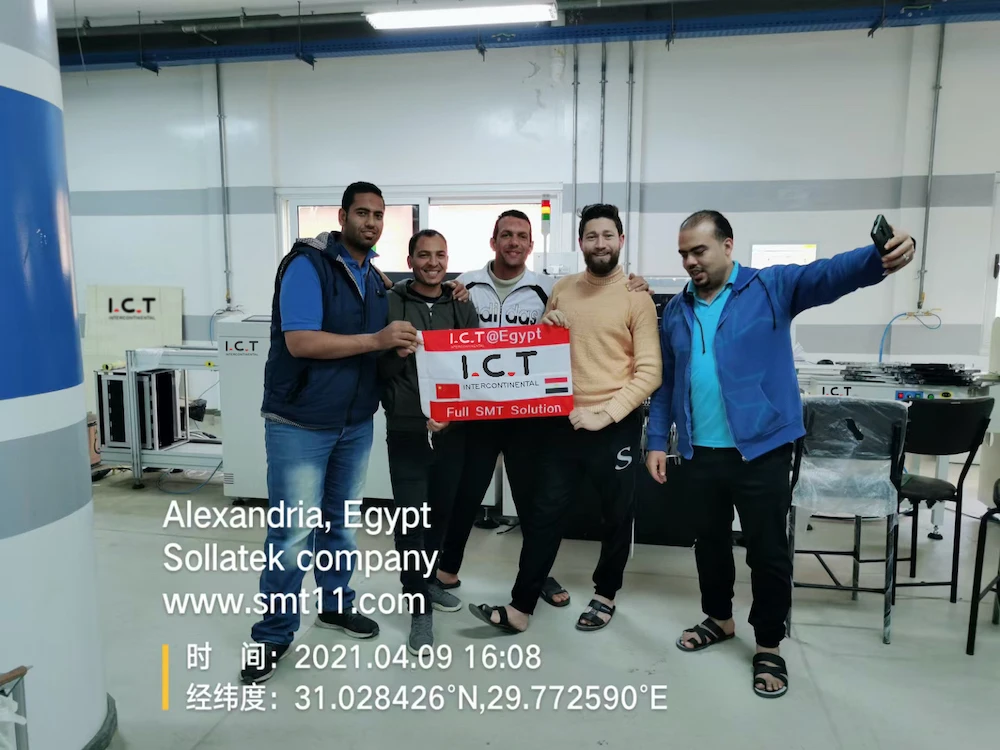
Advantages
The main advantages of SMT over the older through-hole technique are:
Smaller components. As of 2012 smallest was 0.4 × 0.2 mm (0.016 in × 0.008 in: 01005).
Much higher component density (components per unit area) and many more connections per component.
Lower initial cost and time of setting up for production.
Fewer holes need to be drilled.
Simpler and faster automated assembly. Some placement machines are capable of placing more than 136,000 components per hour.
Small errors in component placement are corrected automatically as the surface tension of molten solder pulls components into alignment with solder pads.
Components can be placed on both sides of the circuit board.
Lower resistance and inductance at the connection; consequently, fewer unwanted RF signal effects and better and more predictable high-frequency performance.
Better mechanical performance under shake and vibration conditions.
Many SMT parts cost less than equivalent through-hole parts.
Better EMC compatibility (lower radiated emissions) due to the smaller radiation loop area (because of the smaller package) and the smaller lead inductance?
Disadvantages
Manual prototype assembly or component-level repair is more difficult and requires skilled operators and more expensive tools, due to the small sizes and lead spacings of many SMDs.
SMDs cannot be used directly with plug-in breadboards (a quick snap-and-play prototyping tool), requiring either a custom PCB for every prototype or the mounting of the SMD upon a pin-leaded carrier. For prototyping around a specific SMD component, a less-expensive breakout board may be used. Additionally, stripboard style protoboards can be used, some of which include pads for standard sized SMD comportments. For prototyping, "dead bug" breadboarding can be used.
SMDs' solder connections may be damaged by potting compounds going through thermal cycling.
Solder joint dimensions in SMT quickly become much smaller as advances are made toward ultra-fine pitch technology. The reliability of solder joints become more of a concern, as less and less solder is allowed for each joint. Voiding is a fault commonly associated with solder joints, especially when reflowing a solder paste in the SMT application. The presence of voids can deteriorate the joint strength and eventually lead to joint failure.
SMT is unsuitable for large, high-power, or high-voltage parts, for example in power circuitry. It is common to combine SMT and through-hole construction, with transformers, heat-sinked power semiconductors, physically large capacitors, fuses, connectors, and so on mounted on one side of the PCB through holes.
SMT is unsuitable as the sole attachment method for components that are subject to frequent mechanical stress, such as connectors that are used to interface with external devices that are frequently attached and detached.
Keywords:
SMD Production Line, SMT Line Equipment, PCB Stencil Printer,Semi Auto Stencil Printer, Reflow Machine, PCB Oven, Wave Soldering Desktop Machine, Patch Placement Machine And Heat Seal, High Speed Smart Placement Machine, SMT Coating Machine For PCB, SMT Coating Machine For PCB LED, Coating Spraying Gluing Machine For PCB LED, PCB Board Cutting And Marking Machine, PCB Off-Cut Remover Machine, PCB Reject Conveyor, PCB Router Drill Bits Set With Shank 3.175MM, Solder Soldering Robot, Soldering Robot Welding Soldering, Two Heads Double Solder Soldering Robot
I.C.T is a manufacturer of SMT machines. It mainly provides customers with SMT production lines including SMT Stencil Printers, Pick and place machines, Reflow Oven, AOI Machine, Wave Soldering Machine and PCB Handling Machine etc. I.C.T has more than 25 researches on SMT and DIP technology, for the world Customers provide SMT total solutions. There are successful cases of SMT technical team in Asia, Europe, America, Africa, and Australia.
I.C.T provide SMT solutions at various stages according to the different needs of customers. I.C.T is not only a provider of SMT equipment and technology, but also is the customer's escort in the field of SMT and DIP.
Welcome more people to discuss with us about SMT technologies and solutions, please contact us for more information:
Tel: +86 13670124230 (WhatsApp/Skype/WeChat)
Email: etasmt@foxmail.com







